D. Results from Calculations with a Single Damping Layer |
a. Equilibrium State: Meridional Structure of the Troposphere
For the case of S = 1380 W/m2, integration can be performed over a long time period with L32 simply by including the Rayleigh friction and Newtonian cooling in the upper-most layer. In the discussions below, calculation results will be described for the case in which the time constants of the Rayleigh friction and Newtonian cooling in the upper-most layer are set to 3 hours and the time integration is performed for 1000 days. The disadvantages associated with the inclusion of damping layers and vertical filtering will be discussed by comparing these results to those from Experiment S1380 (which includes seven damping layers and vertical filtering in all layers).
Figure 1(a) shows the meridional distributions of temperature and mass stream function. The temperature distribution pattern is similar to that of the Earth's current atmosphere. Nonetheless, because a gray atmosphere is assumed, the tropopause height is σ= 0.2, which is low. Although the tropopause is evident in this figure, vertical temperature gradient is decreased with implementation of filtering (Figure 1(b)). Regarding the meridional circulation, the Hadley circulation becomes weak in response to implementation of filtering. A comparison between Figures 1(a) and 1(b) reveals that the implementation of filtering causes the strength of the Hadley circulation to become approximately half of the original strength. However, the latitudinal width of the Hadley circulation remains almost the same between the calculations with and without filtering. It is not yet well understood why implementation of filtering weakens the strength of the Hadley circulation. With the filtering, condensation heating in the equatorial region decreases, which is likely to be one factor that contributes to the weakening of the Hadley circulation.
(a) 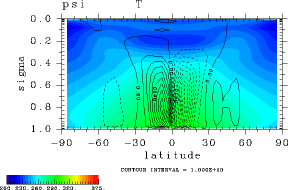
(b) 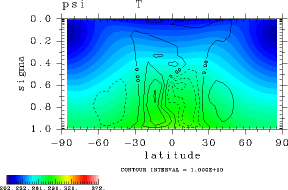
Figure 1: Meridional distributions of temperature (K) and mass stream function (kg/sec). (a) Without filtering and with a single damping layer. (b) Experiment S1380 (filtering included in all layers, seven damping layers). Figure 2 shows the water vapor distributions. With the implementation of filtering, the water vapor content in the upper portion of the tropical troposphere decreases. The deceased water vapor content may be explained by the weakening of the Hadley circulation, which occurs due to the implementation of vertical filtering.
(a) 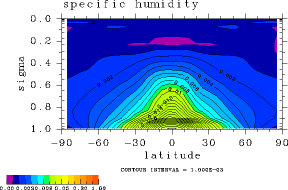
(b) 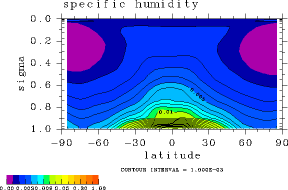
Figure 2: Meridional distributions of specific humidity (kg/kg). (a) Without filtering and with a single damping layer. (b) Experiment S1380 (filtering included in all layers, seven damping layers). Figure 3 shows meridional distributions of relative humidity. With filtering, relative humidity decreases in the equatorial troposphere. As will be described in What Determines the Runaway Limit?, the runaway limit is highly dependent on relative humidity. Therefore, determining whether introducing filtering leads to a relative humidity distribution different from that obtained without filtering is a matter of serious concern. In order to determine the runaway limit accurately, two-grid noise processing, which is a physically sound method, needs to be applied rather than a makeshift solution such as vertical filtering.
(a) 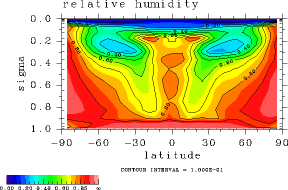
(b) 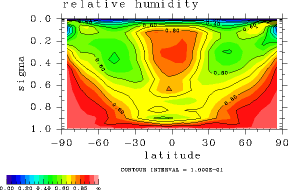
Figure 3: Meridional distributions of relative humidity. (a) Without filtering and with a single damping layer. (b) Experiment S1380 (filtering included in all layers, seven damping layers). Figure 4 shows meridional distributions of zonal wind. Without filtering, zonal wind is easterly within the entire equatorial region, and the structure is similar to that of the actual Earth. However, with the implementation of filtering, the wind in the vicinity of σ= 0.6 becomes westerly, although weak.
(a) 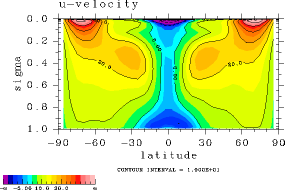
(b) 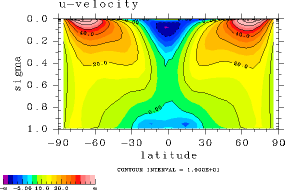
Figure 4: Meridional distributions of zonal wind (m/sec). (a) Without filtering and with a single damping layer. (b) Experiment S1380 (filtering included in all layers, seven damping layers).